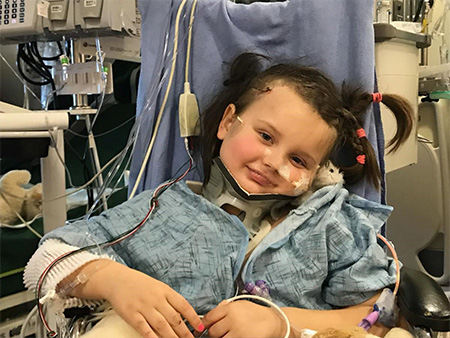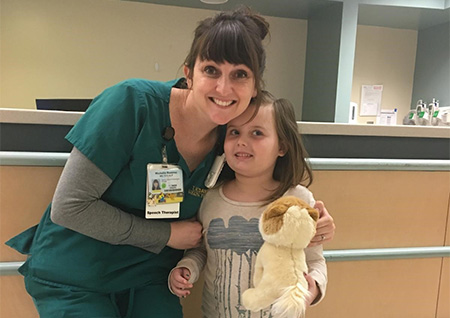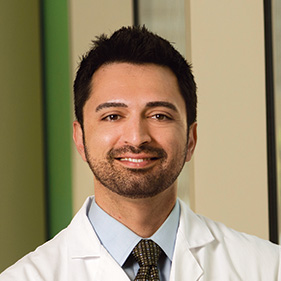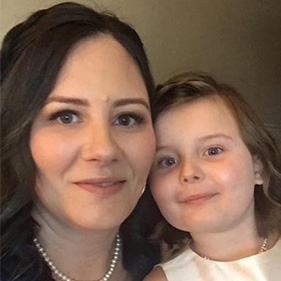It happened so fast. Megan Pitts and her then 6-year-old daughter, Jaelyn, were driving to school one morning in December 2018. They had just gotten on Highway 99 outside Corning on their way to Chico. A three-axle utility truck suddenly merged into their lane, pushing their car into oncoming traffic — and the path of a semi-truck. The truck hit Jaelyn's side of the car. Pitts' only child's life hung in the balance.

"At first I was a mess and felt like I was drowning," Pitts said. "I was so scared."
Jaelyn was lifeflighted to the local hospital in Chico. Once she was stable, she was flown to UC Davis Children's Hospital and admitted to the Pediatric and Cardiac Intensive Care Unit (PCICU/PICU). Pitts had her own injuries to deal with — a fractured collarbone, a concussion and an injured wrist — but waited to address them so she could get to her daughter.
"I needed to be with Jaelyn. I drove to Sacramento and arrived at UC Davis Children's Hospital just emotionally defeated and completely lost," Pitts said. "I was having a really rough time."
'A series of unfortunate events'
The collision was not the only life-changing occurrence. The reason the Pitts family was even on the road that fateful morning: They had been evacuated from their home in Paradise several weeks earlier as the Camp Fire raged. They lost their home in the fire.
"It was a series of unfortunate events," recalled Pitts. "We were staying with family in Corning and our accident was mere weeks after the destruction of our home and town. It was a lot to handle."
And now the family was facing more unknowns. Would Jaelyn survive? Would she be the same happy, chatty girl she was before the accident? So many questions which would rattle any parent's nerves.
"When I arrived at the hospital, I was immediately approached about signing a consent for Jaelyn to have brain surgery," Pitts remembers. "It was terrifying. I didn't know what to expect, and how do you prepare for what you can't foresee?"

Jaelyn was diagnosed with a depressed skull fracture, an injury where the skull is pushed inward, putting pressure on the brain. She had damage to the membrane around the brain, as well as a diffuse axonal injury, a type of traumatic brain injury (TBI) that results from blunt injury to the brain. In the United States, traumatic brain injury is a leading cause of death and disability among children and young adults.
"Jaleyn's injuries were significant and required urgent surgery," said Kia Shahlaie, professor and chair of the Department of Neurological Surgery. "Time is of the essence when it comes to brain injuries. The sooner we intervene, the better chance we give our patients for recovery."
In addition, Jaelyn had lacerations to her spleen, liver and gall bladder, as well as significant bruising to both lungs. She had a stent placed in her gall bladder to drain the fluid that had accumulated and was leaking into her abdomen. But she was alive.
"Due to her type of injury, everything just felt so out of my control," Pitts said. "I did a lot of googling of her type of brain injury, which was highly unadvisable. It left me even more scared and unsure of her future."
Meanwhile, Pitts admitted herself to UC Davis Medical Center to have surgery. She had two plates put in her collarbone which was fractured in three places.
"The team that was working on me was fully aware of what was going on with Jaelyn," Pitts said. "When I was out of surgery, they immediately got me a phone to call up to her room to see how she was doing. They discharged me as quickly as they could so I could go to her in the PICU. Jaelyn's nurses also showed an immense amount of care, which helped me be there for my daughter."
A complicated recovery
Jaelyn's brain surgery went well, although she would remain in a coma for almost a month. During that time Jaelyn experienced what is called "neurostorming," a condition which occurs when the brain's ability to regulate the sympathetic and parasympathetic nervous systems is damaged.
It is very difficult to see a loved one in this condition, and we are fortunate to have a multidisciplinary team at UC Davis that can support the family as they navigate such a challenging time."-Kia Shahlaie, professor and chair of the Department of Neurological Surgery
"After a significant injury, the brain will often swell and controlling that swelling is critical to promote recovery," Shahlaie said. "We often keep patients in a medically induced coma for as long as it takes to allow the brain swelling to resolve. That gives the brain and its surrounding structures the best chance to recover as much as possible."
The care team described it to the family this way: The brain is like a computer that shut down because of the accident. When it reboots, the brain fires off signals to see which connections are broken and if it can repair them. During that process, the body is in fight or flight mode.
For Jaelyn, that meant elevated heart rate, sweating and rigidity on the left side of her body. She was also flailing her right leg, to the point that she injured her foot.
Family members often worry that their loved one's condition is worsening when they experience neurostorming. However, "storming" is a normal effect of severe TBI, albeit hard to watch.
"It is very difficult to see a loved one in this condition, and we are fortunate to have a multidisciplinary team at UC Davis that can support the family as they navigate such a challenging time," Shahlaie said. "We work closely with our ICU physicians, nurses, therapists, and social workers, and spend as much time as possible with our patient's families to guide them through the slow process of recovery after head injury."
When you are at UC Davis, you are on the care team. They want to hear from you. The doctors and nurses wanted to make sure we were comfortable and understood what was going on. They made me feel safe and instilled confidence that they were doing everything they could for Jaelyn."-Megan Pitts, Jaelyn's mom
Pitts soon realized she was a vital part of her daughter's care team, too, and that her opinion and involvement was important.
"When you are at UC Davis, you are on the care team. They want to hear from you," Pitts said. "The doctors and nurses wanted to make sure we were comfortable and understood what was going on. They made me feel safe and instilled confidence that they were doing everything they could for Jaelyn."
Shahlaie agreed that the recovery process is a partnership.
"The family members are critical components of the team that is supporting our patient's path towards healing," Shahlaie added.

The home stretch
Jaelyn spent a month in the PICU before the storming ceased and the team could transition her to the pediatric unit. That's when intensive physical therapy began and her smile returned.
"When she first came out of her coma, we did not know if the same kid was going to be there," Pitts said. "She had to relearn how to walk, talk, eat, stand, everything. But she did everything with the same happy spirit she had before the accident."
Pitts credits Jaelyn's physical, speech and occupational therapy team with the great strides her daughter made.

"They were amazing. The team really made her feel special and quelled her fears," Pitts said. "Part of the reason Jaelyn loves UC Davis so much is that everyone made her feel like she was important."
The Pitts spent the next two months in the hospital as Jaelyn slowly made progress. UC Davis Children's Hospital had become their home away from home.
"I would go down to the café and I would see people who were lost in the hospital," Pitts remembered. "I'd start giving directions and they'd ask if I worked at UC Davis and I'd say, 'No … I just live here.'"
And it wasn't just familiarity with the building that made it feel like home.

"Everyone, even cafeteria staff, enveloped us in kindness and care and community," Pitts recalled. "We felt like we were a priority. Everyone had a part in making this terrible situation a little bit easier."
After almost three months of hospitalization, Jaelyn was finally discharged in March of 2019. The Pitts family relocated to Chico, where their daughter continues to make progress to this day, six years later.
"She has come so far. It's remarkable," Pitts said. "I learned to focus on taking baby steps and celebrating the small victories. Eventually those small victories turned into big ones. She is caught up with her classmates now."
Jaelyn, now 12 years old and in fifth grade, is the same joyful girl her mom wondered if she'd ever see again.
"My daughter is a talker," Pitts laughed. "That was the weirdest thing when she wasn't able to talk. She's back to herself and despite all she went through, Jaelyn loves UC Davis."

Pitts shares that same sentiment about the people and the place that helped saved Jaelyn's life.
"I'm not sure how UC Davis finds their people, but whatever they're doing, they need to keep doing it," Pitts said. "You couldn't be in a better place. Everyone has your best interest at heart."








